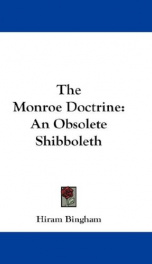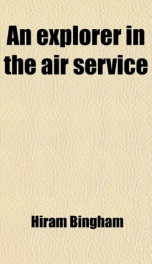Bingham Hiram

2) Suzanne Carroll Hill Hiram Bingham, formally Hiram Bingham III, (November 19, 1875 – June 6, 1956) was an American academic, explorer and politician. He rediscovered the Inca settlement of Machu Picchu in 1911. Later, Bingham served as a member of the United States Senate. Bingham was born in Honolulu, Hawai'i, to Hiram Bingham II (1831–1908), an early Protestant missionary to the Kingdom of Hawai'i, the grandson of Hiram Bingham I (1789–1869), another missionary. He attended O'ahu College, now known as Punahou School in Hawai'i from 1882 to 1892. He went to the United States in his teens in order to complete his education, entering Phillips Academy in Andover, Massachusetts, from which he graduated in 1894. He obtained a degree from Yale University in 1898, a degree from the University of California, Berkeley in 1900, and a degree from Harvard University in 1905. While at Yale, Bingham was a member of Acacia Fraternity. He taught history and politics at Harvard and then served as preceptor under Woodrow Wilson at Princeton University. In 1907, Yale University appointed Bingham III as a lecturer in South American history. Bingham was not a trained archaeologist. Yet, it was during Bingham's time as a lecturer – later professor – at Yale that he discovered the largely forgotten Inca city of Machu Picchu. In 1908, he had served as delegate to the First Pan American Scientific Congress at Santiago, Chile. On his way home via Peru, a local prefect convinced him to visit the pre-Columbian city of Choquequirao. Bingham published an account of this trip in Across South America; an account of a journey from Buenos Aires to Lima by way of Potosí, with notes on Brazil, Argentina, Bolivia, Chile, and Peru (1911). Bingham was thrilled by the prospect of unexplored Inca cities, and in 1911 returned to the Andes with the Yale Peruvian Expedition of 1911. On 24 July 1911, Melchor Arteaga led Bingham to Machu Picchu, which had been largely forgotten by everybody except the small number of people living in the immediate valley (possibly including two local missionaries named Thomas Payne and Stuart McNairn whose descendants claim that they had already climbed to the ruins in 1906). Bingham returned to Peru in 1912 and 1915 with the support of Yale and the National Geographic Society. Machu Picchu has become one of the major tourist attractions in South America, and Bingham is recognized as the man who brought the site to world attention, although many others helped to bring this site into the public eye. The switchback-filled road that carries tourist buses to the site from the Urubamba River is called the Hiram Bingham Highway. Bingham has been cited as one possible basis for the "Indiana Jones" character.[1] His book Lost City of the Incas became a bestseller upon its publication in 1948.[2] Peru has long sought the return of the estimated 40,000 artifacts, including mummies, ceramics and bones, Bingham had plundered from the Machu Picchu site. On 14 September 2007, an agreement was made between Yale University and the Peruvian government for the return of the objects.[3] Though on April 12, 2008 the Peruvian government stated that they had revised previous estimates of 4,000 pieces up to 40,000.[4] Soon after Bingham announced the existence of Machu Picchu others came forward claiming to have seen the city first, such as the British missionary Thomas Payne and a German engineer named J. M. von Hassel.[5] Recent discoveries have put forth a new claimant, a German named Augusto Berns who bought land opposite the Machu Picchu mountain in the 1860s and then tried to raise money from investors to plunder nearby Incan ruins. An 1874 map shows the site of Machu Picchu. [6] He married Alfreda Mitchell, granddaughter of Charles L. Tiffany, on November 20, 1899, and had seven sons: Woodbridge (1901–1986) (professor), Hiram Bingham IV (1903–1988) (diplomat and World War II hero), Alfred Mitchell Bingham (1905–1998) (lawyer and author), Charles Tiffany (1906–1993) (physician), Brewster (1908–1995) (minister), Mitchell (1910–1994) (artist), and Jonathan Brewster Bingham (1914–1986) (Democratic Congressman).[7] After a divorce he married Suzanne Carroll Hill in June 1937. In 1982 Temple University Press published Char Miller's doctoral dissertation on the Bingham family titled "Fathers and sons: The Bingham family and the American mission." Bingham achieved the rank of captain of the Connecticut National Guard in 1916. In 1917, he became an aviator and organized the United States Schools of Military Aeronautics. He served the Aviation Section, U.S. Signal Corps and the Air Service, attaining the rank of lieutenant colonel. In Issoudun, France, Bingham commanded the primary Air Service flying school. In 1922, Bingham was elected Lieutenant Governor of Connecticut, an office he held until 1924. In November 1924, he was elected Governor. On December 16, 1924, Bingham was also elected as a Republican to serve in the United States Senate to fill a vacancy created by the suicide of Frank Bosworth Brandegee. Bingham defeated noted educator Hamilton Holt by a handy margin. Now both Governor-elect and Senator-elect, Bingham served as Governor for one day, the shortest term of any Connecticut Governor. Bingham was re-elected to a full six-year term in the Senate in 1926. Senator Bingham was Chairman of the Committee on Printing and then Chairman of the Committee on Territories and Insular Possessions. President Calvin Coolidge appointed Bingham to the President's Aircraft Board during his first term in the Senate; the press quickly dubbed the ex-explorer "The Flying Senator". Bingham failed in his second reelection effort in the wake of the 1932 Democratic landslide following the Great Depression and left the Senate at the end of his second term in 1933. During World War II, Bingham lectured at several United States Navy training schools. In 1951, Bingham was appointed Chairman of the Civil Service Commission Loyalty Review Board, an assignment he kept through 1953 The Senate Judiciary Subcommittee investigated an arrangement between Bingham, his clerk, and a lobbyist who agreed to pass information on to Bingham's office after executing a plan that was irregular, "even by the standards of his day." Bingham took his clerk off duty, and paid his salary to the lobbyist, thus allowing him to attend as a Senate staffer to closed meetings of the Finance Committee's deliberations on tariff legislation. The initial ruling of the Judiciary Subcommittee was a condemnation of Bingham's scheme; but recommended no formal Senate action. Subsequently, Bingham decided to label the subcommittee's inquiry as a partisan witch hunt, provoking further Senate interest which eventually lead to a Resolution of Censure that passed on November 4, 1929, by a vote of 54 to 22.[8] On June 6, 1956, Bingham died at his Washington, D.C. home. He was interred at Arlington National Cemetery in Arlington, Virginia. Eternity in their Hearts by Don Richardson, Regal Books, Ventura, CA, 1981. ISBN 0-8307-0925-8, pages 34–35
do you like this author?
What readers are saying
What do you think? Write your own comment on this book!
write a commentWhat readers are saying
What do you think? Write your own comment on this author!
write a commentBook list

the monroe doctrine an obsolete shibboleth
Series:
Unknown
Year:
Unknown
Raiting:
3.5/5
This scarce antiquarian book is included in our special Legacy Reprint Series. In the interest of creating a more extensive selection of rare historical book reprints, we have chosen to reproduce this title even though it may possibly have occasional imperfections such as missing and blurred pages, missing text, poor pictures, markings, dark backgrounds and other reproduction issues beyond our control. Because this work is culturally important, we have made it available as a part of our commitment to protecting, preserving and promoting the world's literature. --This text refers to the Paperback edition.
Show more
add to favoritesadd In favorites
Book list

the monroe doctrine an obsolete shibboleth
Series:
Unknown
Year:
Unknown
Raiting:
3.5/5
This scarce antiquarian book is included in our special Legacy Reprint Series. In the interest of creating a more extensive selection of rare historical book reprints, we have chosen to reproduce this title even though it may possibly have occasional imperfections such as missing and blurred pages, missing text, poor pictures, markings, dark backgrounds and other reproduction issues beyond our control. Because this work is culturally important, we have made it available as a part of our commitment to protecting, preserving and promoting the world's literature. --This text refers to the Paperback edition.
Show more
add to favoritesadd In favorites

an explorer in the air service
Series:
Unknown
Year:
Unknown
Raiting:
5/5
Purchase of this book includes free trial access to www.million-books.com where you can read more than a million books for free. This is an OCR edition with typos. Excerpt from book: CHAPTER III WAR FEVER IN WASHINGTON ON my return to Washington on May 13, the city looked more warlike, for in the mean time orders had been issued that all officersonactive duty should wear service uniforms. At the same time this brought out an amusing feature of our unpreparedness which was particularly striking to one who had just been associating with the appropriately uniformed officers of the Royal Flying Corps. They wore wings, but none of them wore spurs, while at Washington the officers in the Aviation Section of the Signal Corps wore spurs, but did not wear wings. About six months later, our military aviators were authorized by the General Staff to wear wings, but when wearing boots were still obliged to wear spurs. Six months later, the War College, after we had been at war for a year, woke up to the ridiculous side of forcing aviators to wear spurs, when obviously from their wings they used airplanes and not horses, and issued anew regulation that aviators when wearing boots would textit{not wear spurs. This was permitted, however, only as long as we were actively engaged in war, and in the following December the rule was changed back again, so that when I returned from France in January, 1919, I received a similar shock to this one after my first visit to Toronto, and found the unfortunate aviator once more compelled to wear spurs when wearing boots. It would be interesting to delve into the inner consciousness of the dear old boys down in the textit{sancta sanctorum of the War College. It is a queer sense of humor that requires a field officer, who in the course of his duties suddenly is called upon to mount his winged steed, to divest himself of his spurs and put them in his pocket for safety. I speak the more feelingly on this matter because of one Sunday ...
Show more
add to favoritesadd In favorites

across south america an account of a journey from buenos aires to lima by way o
Series:
Unknown
Year:
Unknown
Raiting:
2.5/5
Show more
add to favoritesadd In favorites

Inca Land
Series:
Unknown
Year:
Unknown
Raiting:
2.5/5
After the 2007 survey, the sacred citadel of the Inka is declared to be one of the Seven Wonders of the Modern World. Nowadays it is the most famous and visited sightseeing in Peru. The ancient city was discovered in 1911by the expedition of Hiram Bingham, an American academic, explorer and politician – the archeological find that made him famous. He put into practice the fist archeological explorations of the “land of Inka”, what became the title of his first book. All who are interested in majestic ruins that have much to tell about once great civilization, will find the book to be keen pleasure.
Show more
add to favoritesadd In favorites
What readers are saying
What do you think? Write your own comment on this author!
write a commentif you like Bingham Hiram try:
readers also enjoyed
What readers are saying
What do you think? Write your own comment on this author!
write a commentGenre
if you like Bingham Hiram try:
readers also enjoyed
Do you want to exchange books? It’s EASY!
Get registered and find other users who want to give their favourite books to good hands!

